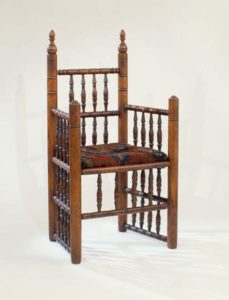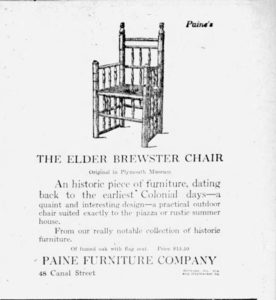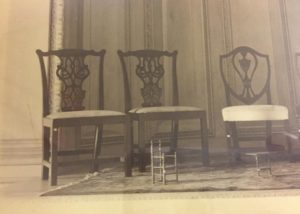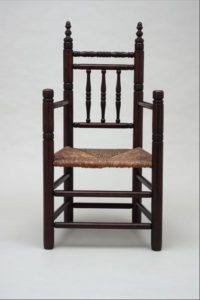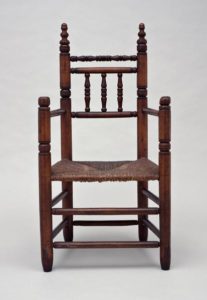The Many Reproductions of Elder Brewster’s Chair
EMERGING SCHOLARS > SUMMER RESEARCH GRANTS
Erica Lome,
American Civilization Program, University of Delaware
Growing up in Massachusetts, you would have to live under Plymouth Rock to miss the significance of the Pilgrims to the story of America. As a historian, I am continually fascinated by the ways we remember and shape the past, which led me to study the Colonial Revival movement from 1876–1945. Of particular interest is the reproduction of so-called “iconic” historic objects during this period. Thanks to the Decorative Arts Trust, I was able to travel to the Museum of Fine Arts, Boston, this summer, where I encountered a reproduction “Elder Brewster” armchair (Figure 1). Samuel Francis Smith received this chair in honor of his patriotic hymn “America” in 1895. The stenciled marks on the back posts identify the gift as “ELDER / BREWSTER / 1620,” but viewers likely recognized the chair immediately. Apart from a distinctive design, the success of reproductions often hinged on the historical significance of the original model. Elder Brewster chairs personified this connectivity through the growing popular interest in the Pilgrims during the late 19th and early 20th centuries. They also offer an excellent example of how the reproduction furniture trade operated in local and national markets.
Owned by Mayflower passenger and Plymouth “Elder” William Brewster, and attributed to furniture maker John Alden, the original Brewster chair is a tall and imposing form, comprised of baluster turned legs, arms, and spindles. Elder Brewster’s chair achieved the status of an important relic after 1830, when descendants donated it to Pilgrim Hall (Figure 2). Afterwards, images and reproductions of the Brewster chair circulated as novelties or souvenirs, particularly during the 1876 Philadelphia Centennial Exhibition.
Samuel Francis Smith’s reproduction may have come from one of the many Boston furniture companies that churned out copies of early-American objects by the 1890’s using a system of flexible mass production. The Paine Furniture Company in Boston advertised having “Elder Brewster Chairs” among its stock, and, in 1912, illustrated a model from their “very notable collection of historic furniture” based on the original at Pilgrim Hall (Figure 3). Paine manufactured furniture in-house and sold wares coming from local cabinetmakers. They claimed their reproduction of Brewster’s chair was a quaint and interesting design, perfect for “the piazza or rustic summer cottage.” Made of fumed oak (a wood finishing technique introduced to the United States by Gustav Stickley in 1901), the chair was very much a product of early-20th-century manufacture and marketing.
Brewster chairs became highly collectible after the Mayflower Tercentenary of 1920, which coincided with the exponential growth of the antiques trade. No longer merely a relic, Elder Brewster’s chair was now regarded as an important primogenitor to a late-17th-century style of turned chairs, which included the related “Carver” form. While associated with Plymouth-based craftsman Ephraim Tinkham II (1649–1713), they were made throughout Eastern Massachusetts.
For those who lacked the resources to acquire a genuine Brewster chair, an acceptable alternative was commissioning a high-end reproduction. Meeting that demand was a class of skilled cabinetmakers, many of whom were immigrants from Eastern and Southern Europe. After emigrating from Lithuania, Jewish cabinetmaker Nathan Margolis developed designs from a close study of antiques, coupled with traditional woodworking techniques. He made several reproductions of 17th-century furniture for Hartford’s Jewish and gentile families, sometimes by salvaging wood from period furniture in poor condition. To promote his business, he made miniatures of antiques for the Children’s Museum in West Hartford in 1930. Among them was a tiny copy of a 17th-century chair, later shown at Horace Bushnell Memorial Hall (Figure 4).
Margolis’ designs quickly gained a reputation for their historical accuracy. When Wallace Nutting entered the reproduction business in the early 1920s, he purchased Margolis’ furniture for his own workers to study. Nutting proved himself as an authority on period furniture with his 1921 publication Furniture of the Pilgrim Century, 1620–1720. Although he valued Pilgrim-style furniture for its “purity” of construction, Nutting was no stranger to modern means of manufacture. Like many who served a broad audience of consumers, Nutting took shortcuts to batch-produce his reproductions, replacing dovetails with dowels, turning legs using machine lathes, cutting wood with a bandsaw, and applying heavy varnish. Close study of Nutting’s “#464 Carver” chair at the Wadsworth Atheneum Museum of Art (Figure 5) reveals some of these details, especially when compared with the Atheneum’s other “Carver” chair from the 17th century (Figure 6).
While reproduction Brewster chairs mainly circulated within the New England market, wholesale furniture manufacturers across the country began to produce “Pilgrim” furniture for a mass audience starting in 1915. The designers at Baker Furniture Company in Grand Rapids based their patterns on the antiques found in Wallace Nutting’s publications (Figure 7). In their effort to produce furniture for modern homes and middlebrow tastes, however, firms realized they could adapt the most recognizable element of the Brewster chair (the turned spindle) and apply it to a broader variety of products. For example, the Kindel Furniture Company’s 1925 “Plymouth” bed was composed of a series of spindles along the headboard. Other companies made radio cabinets and electric clocks with turned components. They also used historically evocative names in their branding, like Berkey & Gay’s “Standish” line of apartment furniture or the “Quincy” bedroom set, referring respectively to Plymouth colonist Myles Standish and Puritan settler Edmund Quincy. The taste for this type of historicist furniture reflected both the commercial spread of the Colonial Revival and the ways in which Americans everywhere embraced the Pilgrim origin story as their own.
The renaissance of pilgrim-style furnishings was brief, and the revival fell out of fashion in the 1930s. Even though the Elder Brewster chair once more receded into memory, it remains to this day an indelible icon of American heritage. With the 400th anniversary of the Mayflower voyage approaching, we might yet again have a chance to own a piece of that history.

